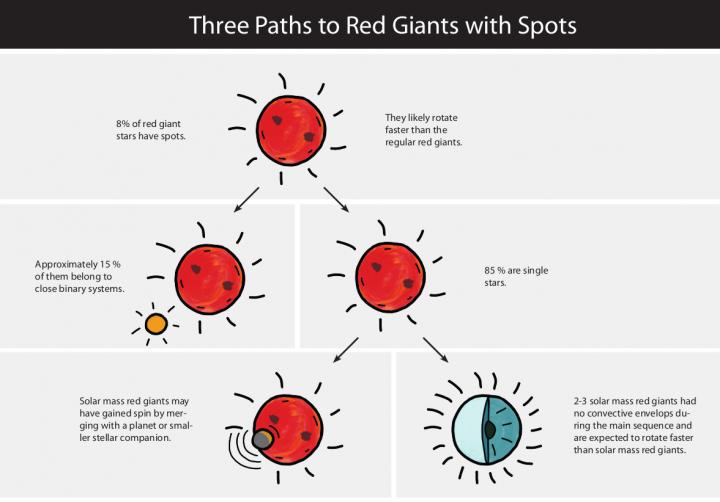
IMAGE: Three Paths to Red Giants with Spots
view more
Credit: MPS / hormesdesign.de
Among the Sun’s most striking features are its sunspots, relatively darker areas compared to the rest of the surface, some of which are visible from Earth even without magnification. Numerous other stars, which like the Sun are in the prime of their lives, are also covered by spots. In red giants, on the other hand, which are in an advanced stage of stellar evolution, such spots were previously considered to be rare. The reason for this difference can be found deep in the interior of stars. In a dynamo process, the interplay of electrically conductive plasma currents and rotation generates a star’s magnetic field that is then washed up to its surface. In some places, particularly strong magnetic fields prevent hot plasma from flowing upwards. These regions appear dark and constitute starspots.
“Rotation and convection are both crucial ingredients for the formation of surface magnetic fields and starspots,” explains Dr. Federico Spada of MPS, co-author of the new study. “Stars with outer convective layers have the potential to generate surface magnetic fields via dynamo action, but only when the star rotates fast enough the magnetic activity becomes detectable,” he adds. Until now, researchers had assumed that almost all red giants rotate rather slowly around their own axis. After all, stars expand dramatically when they develop into red giants towards the end of their lives. As a result their rotation slows down, like a figure skater doing a pirouette with his arms stretched out. The new study led by scientists from MPS and New Mexico State University (USA) now paints a different picture. About eight percent of the observed red giants rotate quickly enough for starspots to form.
The research team scoured the measurement data of about 4500 red giants recorded by NASA’s Kepler space telescope from 2009 to 2013 for evidence of spots. Such spots reduce the amount of light that a star emits into space. Since they usually change only slightly over several months, they gradually rotate out of the telescope’s field of view – and then reappear after some time. This produces typical, regularly recurring brightness fluctuations.
In a second step, the scientists investigated the question why the spotted giants rotate so quickly. How do they muster the necessary energy? “To answer this question, we had to determine as many of the stars’ properties as possible and then put together an overall picture,” says Dr. Patrick Gaulme, lead author of the publication. At the Apache Point Observatory in New Mexico (USA), for example, the researchers studied how the wavelengths of starlight from some of the stars change over time. This allows conclusions about their exact movement. The team also looked at rapid fluctuations in brightness, which are superimposed on the slower ones caused by starspots. The faster fluctuations are the expression of pressure waves propagating through a star’s interior to its surface. They contain information on many internal properties such as the star’s mass and age.
The analysis revealed that approximately 15 percent of the spotted giants belong to close binary star systems, usually constituted of a red giant with a small and less massive companion. “In such systems, the rotational speeds of both stars synchronize over time until they rotate in unison like a pair of figure skaters,” says Gaulme. The slower red giant thus gains momentum and spins faster than it would have without a companion star.
The other red giants with starspots, about 85 percent, are on their own – and yet they rotate quickly. Those with a mass roughly equal to that of the Sun probably merged with another star or planet in the course of their evolution and thus gained speed. The somewhat heavier ones, whose masses are two to three times that of the Sun, look back on a different development. In the heyday of their lives before they became red giants, their internal structure prevented the creation of a global magnetic field that gradually carries particles away from the star. Unlike their magnetic counterparts, which therefore rotate slower and slower over time, their rotation has probably never slowed down significantly. Even as red giants, they still rotate almost as quickly as they did in their youth.
“In total, behind the common observational feature that some red giants have spots, we find three groups of rapidly rotating stars, each of which has a very different explanation. So it’s no wonder that the phenomenon is more widespread than we previously thought,” says Gaulme.
Studies like the present research shed light, among other things, on the evolution of rotation and magnetic activity in stars, and their complex interplay, including the impact on the habitability of the planetary systems they may host. These are among the prime objectives of ESA’s PLATO mission, whose launch is expected by the end of 2026. “We look forward to having the PLATO mission in space; with its unique long-duration observations we will be able to extend the study to other regions of the Milky Way,” concludes Spada.
###
This research was supported by the German Aerospace Center (DLR) under PLATO Data Center grant 50OO1501.
TDnews














